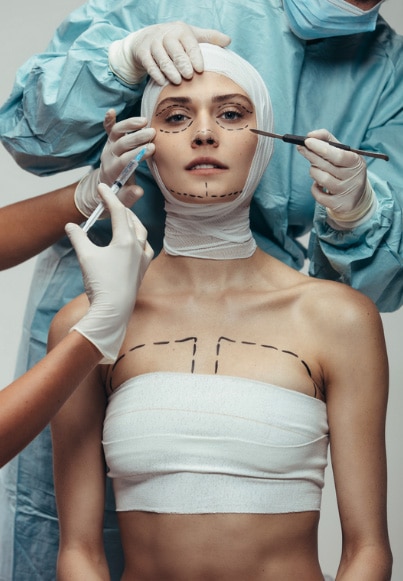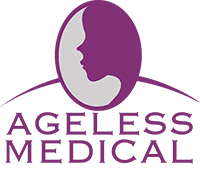The “lunchtime procedure” rose to prominence right alongside Botox — hard on the heels of Y2K (apocalypse, averted; world breathes collective sigh), when lasers were said to “tone” the skin, cow-derived collagen was the filler of choice, and many of today’s most beloved baby-step treatments were still but twinkles in their founders’ eyes. As years passed, and the noninvasive landscape evolved, clocking out for an hour became more meaningful. We could plump our lines with safe sugar gels, restore radiance with gentle fractional lasers, freeze away bulges with CoolSculpting, and still have time to scarf down a salad before our next meeting — at which, of course, any “work” we’d had done would go unnoticed, quietly reflecting the essence of the lunchtime tweak: zero evidence, zero downtime.
Recently, however, doctors have noticed a startling shift. “More and more people are seeking long-lasting or permanent procedures — especially millennials, as time is at a premium, and they don’t want to be coming back every six months for ‘liquid lunchtime’ injections, which are expensive and temporary,” says Dara Liotta, a plastic surgeon in New York City, who’s suddenly seeing minor surgeries, like lip lifts and chin implants, edging out no-downtime alternatives.

In fact, cosmetic surgeries of all kinds are spiking, according to the American Society for Aesthetic Plastic Surgery (ASAPS). Frustrated with noninvasive options, “which promise real results but deliver minimal differences,” New York City plastic surgeon Melissa Doft says many patients are forgoing the slow-and-steady pursuit of tighter arms and abs via nonsurgical means (CoolSculpting, Vanquish, Kybella) in favor of a single round of liposuction. They’re putting the thousands they’d normally spend on fillers and devices into mini face- and neck-lifts.
We reported on the return of the face-lift last spring — how it’s not only back, but better than ever. And in the short time since our story went to press, the surgery has gained even more momentum, experiencing a near 22 percent jump in that one year alone, notes ASAPS.
As the face-lift’s popularity continues to soar, its fans are getting younger. “Some patients start inquiring about the procedure in their 30s, but most often, it’s a good choice in the 40s, as the surgery tends to be less extensive [when done earlier in life], and the results can easily be maintained with injectables to very natural effect,” says David Shafer, a plastic surgeon in New York City. Call it the new face of prevention. “The most common comment I hear from older patients after having a face-lift is, ‘I should’ve done this 10 years ago,’” he adds. Beyond the plain-and-simple fact that younger bodies heal faster, Gen-Xers can typically manage the required off-time just as easily as their AARP counterparts, says Shafer, resuming work duties from home a few days post-surgery and returning to the office a week or two later.
Whether this youth movement has driven the destigmatization of plastic surgery, or perhaps rallied because of it, one thing is clear: Occasional nip-tucks are now far from taboo. The surrounding fear factor has subsided, too. Liotta credits intraoperative videos on SnapChat and Instagram with demystifying the surgical process; and the uncensored patient testimonials and personalized MD advice on sites like RealSelf with “making the whole process less frightening.”
Outside the operating room, cosmetic dermatologists are witnessing a similar elevation of expectations — with treatment plans climbing accordingly. New York City dermatologist Macrene Alexiades, who participated in the original FDA trial for Thermage — a no-downtime external radiofrequency (RF) machine — believes “we’ve hit a plateau in terms of what we can achieve with skin-surface, tightening technologies,” she says, going so far as to liken their lifting effect to the Emperor’s New Clothes: invisible, in many instances. When Thermage launched in 2002, “we were so excited that there was, for the first time in history, a ‘nonsurgical alternative to the face-lift,’” she recalls. “But over time, it became obvious that for certain people if didn’t offer much of an improvement.”
While dozens of collagen- and elastin-stimulating RF technologies have been developed since then — each generation better than the last — “their efficacy has finally maxed out,” says Alexiades, compelling pros to turn to more invasive tools, like the Profound, which uses microneedles to deliver RF energy below the skin’s surface, thereby heating the dermis to 67 degrees Celsius to regenerate collagen, elastin, and hyaluronic acid for tauter skin. The $4,500 procedure demands both topical and injectable numbing solutions, and begets at least one week of swelling and bruising. The tradeoff? “In a randomized, blinded, controlled trial published in the Journal of the American Medical Association, the Profound delivered 37 percent of the result of a surgical face-lift,” says Alexiades, who was a lead author on the study.
Intense resurfacing treatments are trending, too — all designed to make short work of sun damage. New York City dermatologist Robert Anolik has taken to layering various lasers in a single appointment to maximize payoff and stack downtime. For run-of-the-mill mottling and lines, he generally recommends a sweeping nonablative fractional treatment of the face, neck, and chest to improve collagen quality and skin tone, followed by a targeted attack on individual sunspots — sometimes as many as 20 at a time — with the Q-switched Ruby laser. (Nonablative lasers spare the skin’s surface, FYI; ablative ones strip it off.) For about a week, the skin is pink and flaky with scabbed-over spots that gradually peel away. When UV damage is more extreme, he’ll tack on an ablative blasting of deeper wrinkles around the mouth and eyes. “These patients look like burn victims for about one week after treatment — they’re crusted and swollen, but not in any pain — and then, once that heals, the skin is pink for two to four weeks,” he says. Tinted sunscreens are a godsend during this stretch.
Ablative fractional procedures are really “in a league of their own,” says New York City dermatologist Dendy Engelman — their results unattainable by even the most extensive series of weaker laser treatments. Her favorite is what she calls “deep Fraxel with PRP” — that’s an ablative CO2 fractional laser immediately followed by either a topical application of or injections of, platelet-rich plasma (PRP) derived from patients’ blood. (Derms call PRP “liquid gold,” because it’s a rich source of growth factors, which speed healing and boost collagen growth — one Allure contributor recently tried using PRP injections to minimize stretch marks.)
Fully ablative eyelid resurfacing is a top fix in dermatologist Ellen Marmur’s New York City office — that’s “hardcore erbium YAG laser for the vaporization of wrinkles and tightening of skin to prevent hooding of the lids and that crepey, crinkly texture that comes with age,” she explains. Patients are usually “swollen like a goldfish” for three days, and then red with possible bruising for up to five.
Perhaps the most fascinating aspect of the downtime rival: More than simply accepting such side effects, people are actually embracing them — wearing them as badges of honor. “These patients have a clear goal in mind; they’re determined to achieve it as quickly as possible; and they’re less embarrassed to leave the office red or flaky,” says Los Angeles dermatologist Michael Kassardjian. In fact, some so strongly associate recovery with results, that “if they don’t see that peeling and redness, they don’t believe they’ve had a worthwhile treatment, and they’ll request something stronger next time,” he says.
Holding a special appeal for those partial to public displays of downtime is the aptly named zombie peel, which renders skin blue and bloody post-treatment. (Total. Insta-bait.) It combines a controlled-depth trichloroacetic acid (TCA) peel with an ablative CO2 laser resurfacing to firm the skin and smooth away wrinkles, spots, and scars, explains Sameer Bashey, a dermatologist in Beverly Hills, who frequently posts about the peel on social media. The acid’s blue base allows doctors to see how much of the face has been covered, and precisely how deep the acid is penetrating — they want it diving way down to build collagen and elastin. The laser bolsters this action while wiping out surface irregularities.
Patients sleep through the procedure — courtesy of IV sedation — and awake without pain, since “the peel temporarily dulls the nerve endings in the skin,” Bashey says, which eases the aftermath. (Those nerves regenerate in the subsequent weeks.) After a few days, the transient blue tinge fades to a persistent pink — which can last up to six weeks — and patients are encouraged to hide out and avoid exercise for at least 10 days. “The tightening effect is rather remarkable,” notes Bashey — “sometimes on par with that of a face-lift.” The cost can be comparable, too, reaching upwards of $11K depending on the amount of correction desired.
